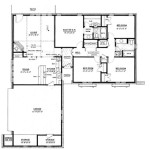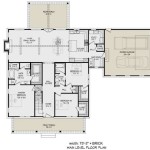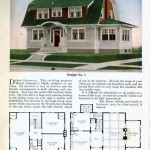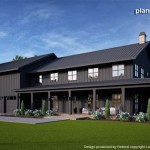Empty Nester House Plans Designs are a particular type of architectural plan tailored to meet the needs of homeowners who are transitioning into an empty nest phase of life. These designs typically cater to individuals or couples whose children have grown up and left the household, leaving them with a surplus of space and a desire for a home that better suits their current lifestyle.
For instance, empty nesters may seek homes with smaller square footage, single-story layouts for convenience, and open floor plans that promote a sense of spaciousness. They may also prioritize features such as energy efficiency, low-maintenance landscaping, and accessibility features to ensure comfort and ease of living as they age.
As we delve deeper into this article, we will explore various aspects of Empty Nester House Plans Designs, including popular design trends, functional considerations, and tips for creating a home that perfectly aligns with this unique stage of life.
Listed below are 10 important points to consider when designing an Empty Nester House Plan:
- Single-story living
- Smaller square footage
- Open floor plans
- Energy efficiency
- Low-maintenance landscaping
- Universal design features
- Smart home technology
- Outdoor living spaces
- Proximity to amenities
- Personalization
These considerations will help ensure that your new home is comfortable, convenient, and perfectly suited to your needs as an empty nester.
Single-story living
Single-story living is a popular choice for empty nesters as it offers a number of advantages. First, it eliminates the need to climb stairs, which can be a safety hazard for older adults. Second, it makes it easier to get around the house, especially if you have mobility issues. Third, it can create a more open and spacious feel, which is ideal for empty nesters who want to downsize from their larger family home.
There are a number of different single-story house plans available to choose from. Some popular options include ranch-style homes, cottage-style homes, and bungalow-style homes. These homes typically have all of the living space on one level, with no stairs to climb. They also often have open floor plans, which make them feel more spacious and airy.
If you are considering a single-story home, there are a few things to keep in mind. First, make sure that the home has enough space for your needs. You may want to consider a home with at least three bedrooms and two bathrooms. Second, make sure that the home is accessible for you. This means that it should have wide doorways and hallways, and that it should be easy to get in and out of the home.
Single-story living can be a great option for empty nesters who want a home that is safe, convenient, and comfortable. If you are considering downsizing to a single-story home, be sure to do your research and find a home that meets your needs.
Smaller square footage
Empty nesters often choose to downsize to a smaller home when their children leave the nest. This can be a wise financial decision, as it can save on property taxes, utilities, and maintenance costs. It can also be a great way to simplify your life and reduce your environmental footprint.
There are a number of benefits to living in a smaller home. First, it is easier to clean and maintain. This can be a major advantage for empty nesters who no longer have the time or energy to keep up with a large home. Second, smaller homes are often more energy-efficient, which can save you money on your utility bills. Third, smaller homes can be more comfortable and cozy, which can be ideal for empty nesters who are looking for a more intimate living space.
If you are considering downsizing to a smaller home, there are a few things to keep in mind. First, make sure that the home has enough space for your needs. You may want to consider a home with at least two bedrooms and one bathroom. Second, make sure that the home is accessible for you. This means that it should have wide doorways and hallways, and that it should be easy to get in and out of the home. Third, make sure that the home is in a location that you like and that is convenient for your needs.
Downsizing to a smaller home can be a great way to save money, simplify your life, and reduce your environmental footprint. If you are an empty nester who is considering downsizing, be sure to do your research and find a home that meets your needs.
Open floor plans
Open floor plans are a popular choice for empty nesters for a number of reasons. First, they can make a home feel more spacious and airy. This is especially important for empty nesters who are downsizing from a larger home. Second, open floor plans can make it easier to entertain guests. This is because they allow for easy flow between different areas of the home, such as the living room, dining room, and kitchen.
- Create a more spacious feel
Open floor plans can make a home feel more spacious and airy. This is because they eliminate the walls that typically divide different rooms, such as the living room, dining room, and kitchen. This creates a more open and inviting space that is perfect for entertaining guests or simply relaxing at home.
- Make it easier to entertain guests
Open floor plans make it easier to entertain guests because they allow for easy flow between different areas of the home. This means that you can easily move from the living room to the dining room to the kitchen without having to go through a hallway or doorway. This can be a major advantage for empty nesters who like to host parties or gatherings.
- Provide more natural light
Open floor plans often have more windows than traditional homes. This is because there are no walls to block the light. This can make the home feel more bright and airy, which can be a major benefit for empty nesters who want to save on energy costs.
- Be more accessible
Open floor plans can be more accessible for empty nesters who have mobility issues. This is because there are no stairs or hallways to navigate. This can make it easier to get around the home and can help to prevent falls.
Open floor plans are a great option for empty nesters who want a home that is spacious, airy, and easy to navigate. If you are considering an open floor plan for your new home, be sure to do your research and find a plan that meets your needs.
Energy efficiency
Energy efficiency is an important consideration for empty nesters who are looking to downsize to a new home. By choosing a home that is energy-efficient, you can save money on your utility bills and reduce your environmental impact.
There are a number of ways to make your home more energy-efficient. Some of the most effective methods include:
- Insulating your home
Insulation is one of the most important factors in determining the energy efficiency of your home. By adding insulation to your attic, walls, and floors, you can reduce the amount of heat that escapes from your home in the winter and the amount of heat that enters your home in the summer. This can lead to significant savings on your heating and cooling costs.
- Installing energy-efficient windows and doors
Windows and doors are another major source of heat loss in the home. By installing energy-efficient windows and doors, you can reduce the amount of heat that escapes from your home in the winter and the amount of heat that enters your home in the summer. This can lead to significant savings on your heating and cooling costs.
- Using energy-efficient appliances
Appliances are another major consumer of energy in the home. By choosing energy-efficient appliances, you can reduce your energy consumption and save money on your utility bills. Look for appliances with the Energy Star label, which indicates that they meet certain energy-efficiency standards.
- Installing a programmable thermostat
A programmable thermostat can help you save energy by automatically adjusting the temperature in your home based on your schedule. For example, you can program the thermostat to lower the temperature at night when you are sleeping or away from home. This can lead to significant savings on your heating and cooling costs.
By making these simple changes to your home, you can significantly improve its energy efficiency and save money on your utility bills. This can be a major benefit for empty nesters who are looking to downsize to a new home.
In addition to the above measures, there are a number of other things you can do to make your home more energy-efficient. These include:
- Unplugging electronics when you are not using them
- Turning off lights when you leave a room
- Taking shorter showers
- Washing clothes in cold water
- Hanging clothes to dry instead of using a dryer
By following these tips, you can make your home more energy-efficient and save money on your utility bills.
Low-maintenance landscaping
Low-maintenance landscaping is a great way to save time and money while still enjoying a beautiful yard. It is especially beneficial for empty nesters who may not have the time or energy to care for a large, high-maintenance yard.
- Choose native plants
Native plants are well-adapted to the local climate and soil conditions, so they require less water and fertilizer than non-native plants. They are also more resistant to pests and diseases, which can save you money on pesticides and herbicides.
- Use mulch
Mulch is a layer of material, such as bark, wood chips, or compost, that is spread around plants. Mulch helps to retain moisture in the soil, suppress weeds, and regulate soil temperature. This can reduce the amount of time you spend watering, weeding, and fertilizing your plants.
- Install a drip irrigation system
A drip irrigation system is a type of irrigation system that delivers water directly to the roots of plants. This is a more efficient way to water your plants than using a sprinkler system, which can waste water by evaporating or running off. Drip irrigation systems can also be automated, so you can water your plants even when you are away from home.
- Consider artificial turf
Artificial turf is a great option for empty nesters who want a beautiful lawn without the hassle of mowing, watering, and fertilizing. Artificial turf is also very durable and can withstand heavy use, making it a good choice for families with pets or children.
By following these tips, you can create a low-maintenance landscape that is beautiful, easy to care for, and affordable. This can free up your time and money so that you can enjoy your retirement years.
Universal design features
Universal design features are design elements that make a home accessible and comfortable for people of all ages and abilities. These features can be especially beneficial for empty nesters who may be experiencing mobility issues or other age-related changes.
Some common universal design features include:
- No-step entrances
No-step entrances are essential for people who use wheelchairs or have difficulty walking. They can also be beneficial for people who are carrying heavy objects or pushing strollers.
- Wide doorways and hallways
Wide doorways and hallways allow for easy movement of wheelchairs, walkers, and other mobility devices. They can also be helpful for people who have difficulty walking or carrying objects.
- Lever door handles
Lever door handles are easier to use than traditional doorknobs, especially for people with arthritis or other hand mobility issues.
- Roll-in showers
Roll-in showers are showers that have no curb or threshold, making them easy to enter and exit for people who use wheelchairs or have difficulty stepping over a high threshold.
In addition to these specific features, there are a number of other design elements that can make a home more universally accessible. These include:
- Open floor plans
Open floor plans allow for easy movement throughout the home, which can be beneficial for people who use wheelchairs or have difficulty walking.
- Single-story living
Single-story living eliminates the need to climb stairs, which can be a safety hazard for people with mobility issues.
- Smart home technology
Smart home technology can make it easier for people to control their home environment, which can be especially beneficial for people with disabilities.
By incorporating universal design features into your home, you can create a space that is safe, comfortable, and accessible for people of all ages and abilities.
Smart home technology
Smart home technology can make it easier for empty nesters to live independently and safely in their homes. By automating tasks and providing remote access to home systems, smart home technology can give empty nesters peace of mind and a sense of security.
- Remote access and control
Smart home technology allows empty nesters to control their home systems remotely, even when they are away from home. This can be especially beneficial for empty nesters who travel frequently or who have difficulty getting around. With smart home technology, empty nesters can lock and unlock their doors, adjust their thermostat, and turn on and off their lights from anywhere in the world.
- Automated tasks
Smart home technology can also be used to automate tasks around the home. For example, empty nesters can set up their smart home system to automatically turn on the lights when they come home at night, or to start the coffee maker in the morning. This can save empty nesters time and energy, and it can also help them to live more independently.
- Safety and security
Smart home technology can also be used to improve safety and security in the home. For example, empty nesters can install smart smoke detectors and carbon monoxide detectors that will send them an alert if there is a problem. They can also install smart security cameras that will allow them to monitor their home remotely.
- Health and wellness
Smart home technology can also be used to improve health and wellness. For example, empty nesters can install smart scales that will track their weight and body fat percentage. They can also install smart blood pressure monitors that will track their blood pressure and send them an alert if it is too high or too low.
Smart home technology is a great way for empty nesters to live more independently, safely, and comfortably in their homes. By automating tasks, providing remote access to home systems, and improving safety and security, smart home technology can give empty nesters peace of mind and a sense of security.
Outdoor living spaces
Outdoor living spaces are an important consideration for empty nesters who want to enjoy the outdoors without having to leave their home. These spaces can be used for relaxing, entertaining, or simply enjoying the fresh air. When designing an outdoor living space for an empty nester home, there are a few things to keep in mind.
First, consider the size of the space. Empty nesters may not need a large outdoor space, but they should have enough room to comfortably entertain guests or simply relax. Second, consider the location of the space. The outdoor living space should be easily accessible from the home, but it should also be private and secluded.
Third, consider the type of activities that you want to do in the outdoor living space. If you enjoy cooking, you may want to include a built-in grill or outdoor kitchen. If you enjoy gardening, you may want to include a raised garden bed or a small greenhouse. And if you simply want to relax, you may want to include a comfortable seating area with a fire pit or water feature.
Finally, consider the style of the outdoor living space. The style should complement the style of your home, but it should also reflect your personal taste. If you prefer a traditional style, you may want to use natural materials such as wood and stone. If you prefer a more modern style, you may want to use sleek lines and contemporary materials such as metal and glass.
By following these tips, you can create an outdoor living space that is perfect for your needs. This space will be a great place to relax, entertain, and enjoy the outdoors.
Here are a few more tips for designing an outdoor living space for an empty nester home:
- Choose comfortable furniture that is easy to get in and out of.
- Provide plenty of shade, either with umbrellas, awnings, or trees.
- Install outdoor lighting to extend the use of your space into the evening hours.
- Add some personal touches, such as plants, flowers, or artwork, to make the space your own.
With a little planning, you can create an outdoor living space that is both beautiful and functional. This space will be a great place to enjoy the outdoors and create lasting memories with family and friends.
Proximity to amenities
Proximity to amenities is an important consideration for empty nesters who are looking to downsize to a new home. Empty nesters may want to live close to shopping, dining, entertainment, and healthcare facilities. This can make it easier to get around and enjoy the activities that they want to do.
- Convenience
Living close to amenities can make life easier for empty nesters. They can easily walk or drive to the grocery store, the pharmacy, or the doctor’s office. This can save them time and energy, and it can also make it easier to stay independent.
- Socialization
Living close to amenities can also help empty nesters to socialize and stay active. They can easily meet up with friends for coffee or lunch, or they can attend events at the local library or community center. This can help them to stay connected to their community and to avoid feelings of isolation.
- Increased property value
Homes that are located close to amenities tend to have higher property values. This is because amenities are desirable to buyers, and they are willing to pay more for a home that is located in a convenient location.
- Peace of mind
Living close to amenities can give empty nesters peace of mind. They know that they can easily get to the places they need to go, and they don’t have to worry about being isolated or stranded if they have an emergency.
When choosing a new home, empty nesters should carefully consider the proximity to amenities. This can help them to find a home that meets their needs and allows them to live a comfortable and fulfilling life.
Personalization
Personalization is an important aspect of any home design, but it is especially important for empty nesters. After all, this is a home that you will be living in for many years to come, and you want to make sure that it reflects your personality and style. There are many ways to personalize your empty nester home, from choosing the right colors and finishes to adding your own personal touches.
One of the best ways to personalize your home is to choose colors and finishes that you love. If you prefer a traditional style, you may want to choose warm colors and classic finishes. If you prefer a more modern style, you may want to choose cooler colors and contemporary finishes. No matter what your style, there are endless possibilities when it comes to choosing colors and finishes for your home.
Another way to personalize your home is to add your own personal touches. This could include anything from artwork and photographs to furniture and accessories. When choosing personal touches, it is important to choose items that have meaning to you. This could be a piece of art that you inherited from your family, a photo of your children or grandchildren, or a favorite piece of furniture that you have had for years.
No matter how you choose to personalize your home, the most important thing is to create a space that you love and that reflects your personality. This is your home, and it should be a place where you feel comfortable and happy.
Here are a few more tips for personalizing your empty nester home:
- Start by decluttering and getting rid of anything you don’t need or use.
- Choose a color scheme that reflects your personality and style.
- Add personal touches, such as artwork, photographs, and furniture that has meaning to you.
- Make sure your home is comfortable and inviting.
- Don’t be afraid to experiment and have fun with your design.










Related Posts








